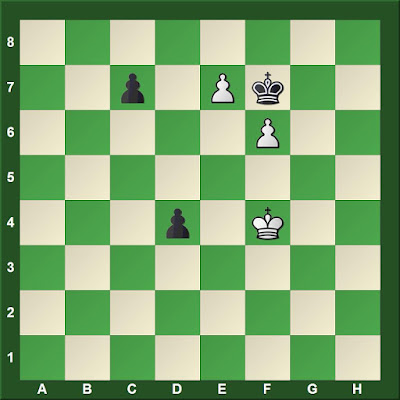These two compositions were brought to my attention through Genrikh Moiseyevich Kasparian,
888 Miniature Studies (2010), which I acquired last week. This book is an expansion of the author's
555 Miniature Studies (1975). This earlier book, as far as I know, was never translated into English. The present work was left in manuscript at the time of the author's death, but was brought into publication fifteen years later through the assistance of his son, Sergei Kasparian.
White to move
 |
| Johann Berger 1888 |
This study is number 17 in Kasparian. I read through the solution, which is under the diagram, and then proceeded to try making sense of it. When I thought I had reached a reasonable understanding of the ideas, I tried playing it against Stockfish. My first effort led to failure, so I returned to the solution. In my second try against Stockfish, I was able to win easily. I continued working with the problem, however, seeking to develop the ability to explain in plain English to beginning chess players how to understand the solution.
Having given the solution so much attention, I looked in Berger's book,
Theorie und Praxis der Endspiele (1890) where I was surprised to find the problem was credited to an obscure publication,
Columbia Chess Chronicle III, no. 13 (1888). After some searching, I found the problem on the cover of the issue named, where Berger is confirmed as the composer.
Readers of this blog are encouraged to offer their solutions in the comments below. I will refrain from presenting the solution, except in reply to comments.
White to move
 |
| Karl Behting 1894 |
Kasparian credits C. Behting,
Rigaer Tageblatt 1894 (21). Tageblatt translates as "daily paper". I do not know whether that is the name of a specific news publication or a generic term for one or more of several newspapers in Riga. Its use in other publications that I have examined suggets that it is a specific paper.
Karl Behting (Kārlis Bētiņš) was a Latvian chess player and composer. The Latvian Gambit bears its name because he studied it with other Riga players and published an article in
St. Petersburger Zeitung (1909). Many of his compositions were published in newspapers in Riga, then were republished in books and magazines that culled problems from other publications. I found a version of this problem in
Baltische Schachblätter, Issues 6-8 (1898). Below this point, I am presenting the problem as found there and the solution. Of interest in the solution is a technical chess term that is new to me and worth adding to the lexicon of chess terms:
Tempozug.
Tempozug means to waste a tempo; that is, to make a move that does not change the position. A Tempozug places the opponent in
Zugzwang.
Solution to Second Problem
Behting's composition in
Baltische Schachblätter.
Credit here is given to Johann Behting, Karl's older brother. A 1930 publication,
Studien und Problem lists both Johann and Karl as authors, suggesting collaboration. Were there separate publications of this problem by both brothers? The position attributed to Johann begins one move earlier than the version of the same problem that Kasparian credits to Karl. Some insights into the compositions of these brothers is offered by John Beasley, "Some Studies by Johann and Carl Behting,"
British Endgame Study News 52 (September 2007),
www.jsbeasley.co.uk/besn/s52.pdf.
Solution from
Baltische Schachblätter.

























